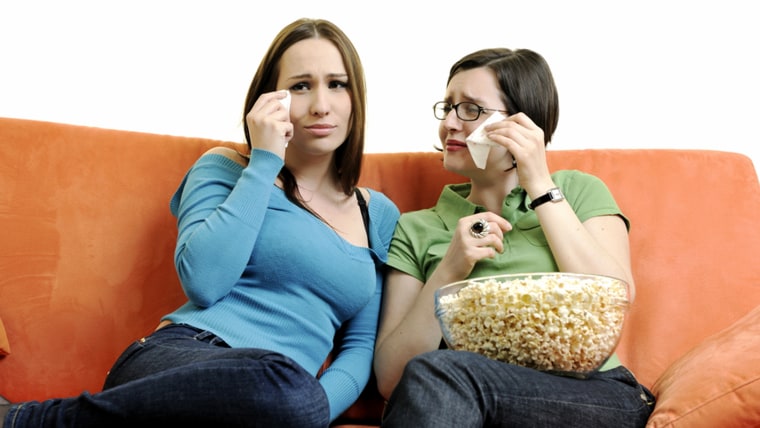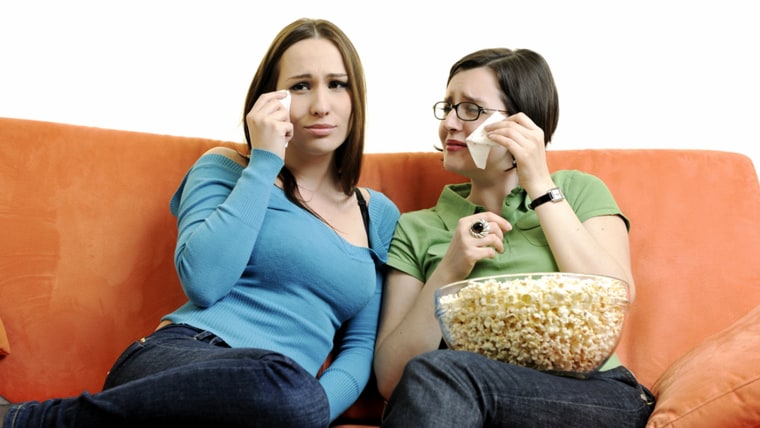If you’ve ever wept, giggled or grieved inside a movie theater, you know: Some of our most intense emotional experiences come when we’re watching a film.
“Given that all you’re perceiving are the vibrations of some speakers and a succession of still digital images on a screen – why do we take that as real?” asked Jeffrey Zacks, a professor of psychology and director of the Dynamic Cognition Laboratory at Washington University in St. Louis.
He revealed some of the answers to TODAY and in his new book, “Flicker: Your Brain on Movies,” which examines how —if our brains evolved to deal with the live, three-dimensional real world — we have such powerful reactions to films.
The following is an edited version of that interview.

How are filmmakers able to push our buttons?
One way that we perceive emotion in film is through I process I call the Mirror Rule, which says that it’s a good idea to mimic the visual input that you’re seeing. So if you walk up to somebody and they smile at you, it’s good to smile back.
If you watch somebody in the theater and there’s a smiling face filling the screen, most of the audience is going to pop a little bit of a smile.
When we’re smiling, we tend to feel happier. When we’re frowning, we tend to feel angrier. So that combination of the Mirror Rule and the reading of emotion by the brain off the current state of the body is enough to produce emotion.
In film, a filmmaker has the opportunity to integrate those things very tightly. He can control exactly what’s shown of the face and what else is present. And the viewer has much less opportunity to walk away or focus on other things.
Why do we cry at movies?
You’ve got this facial mirroring that causes your face to wind up in a sad pose, and that evokes a sad emotion. You’ve identified with the character and you’re reasoning about the fact that they would be sad and that produces empathetic sadness in you.
Music plays a big role in emotion and film. Often, sad movies have slow minor key music at the points that they’re trying to get you to cry.
We encounter minor key music in real life, we see people who cry and we watch bad things happen to other people—all these things make us feel sad. But in a movie, you can crank those things up to 11. You can put a big crying face that fills up your whole visual field so there’s no other place to look.
You can set up situations that are most upsetting and put three of them in a film and then you can play sad music. You put all those things together and it’s just taking the mechanisms that we encounter in real life and just really pushing all the buttons at once.
Do you think it’s easier to cry at the movies?
I’ve had that experience myself. In real life, I’m a pretty stoic person but I’ve been at movies that were not even good movies that had me bawling like a baby. Some of the emotional stimuli that we create in movies are supernormal stimuli.
Is the same true for happiness?
Absolutely, but in both movies and in real life, the tragic thing is it’s a lot easier to make people sad than to make people happy.
Why do we flinch when something is thrown on screen?
Another general principle of human behavior is what I call the Success Rule. It says that when you’re confronted with stimuli, you tend to perform the behaviors that produced good outcomes in response to similar stimuli in the past.
In the past, when we have perceived a looming object, that meant that there was something coming at your head and the good thing to do would be to duck. It’s evolutionarily baked in. Do what’s worked for you in the past.
So we have this whole lifetime of experience outside the theater with how to deal with physical objects and their movement. We don’t turn that off when we go sit down. We can’t shut that down 100 percent or if something really was flying at my head, I wouldn’t respond appropriately.
Does all of this extend to watching TV or YouTube videos on your computer?
Yes, though bigger screens produce more robust responses. So your response to watching “Sophie’s Choice” on your iPhone is probably not going to be as strong as it would be in the theater because of the smaller screen and because you’re not sitting in a dark room where everything else is cut off.
The general mechanisms are operating in the same way, it’s just a question of to what degree you are able to block out the other sources of information in your life.
What about when you go see a play in a theater – do the same mechanisms apply?
Yes, except that – coming back to the ability of movies to take it to 11—there’s a bunch of real world constraints that apply to theater that don’t apply to film that make it harder to amp up a lot of these patterns.
You can’t do close ups, you can’t do cuts, you have much less control over where people are looking in the theater than in a film. That means you’re going to have less consistent and less powerful responses overall. That’s not a bad thing, it’s just a difference.
